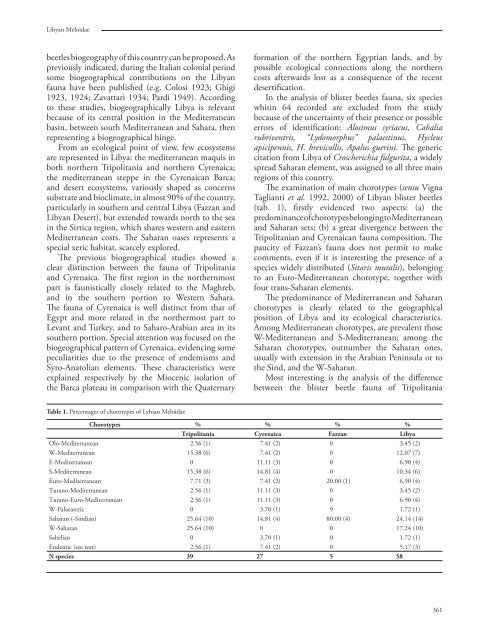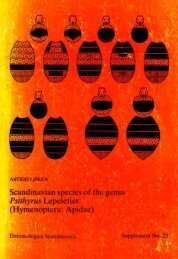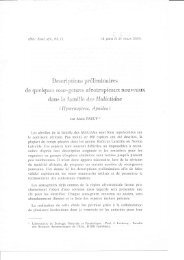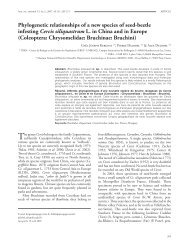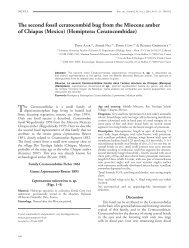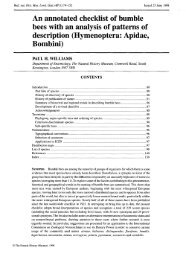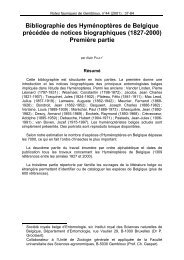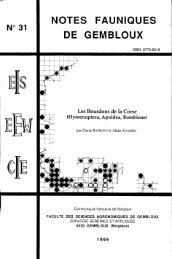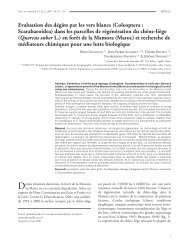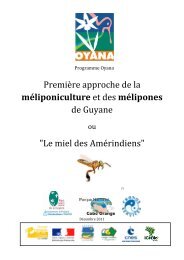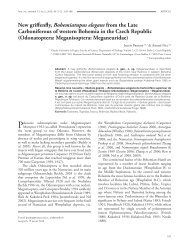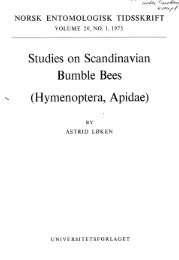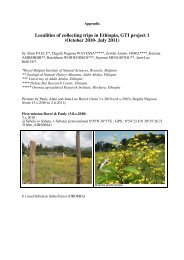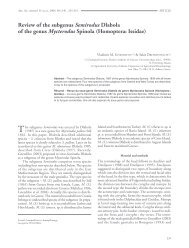Bologna 2009 - Beetles and Rock Art in Libya - Free
Bologna 2009 - Beetles and Rock Art in Libya - Free
Bologna 2009 - Beetles and Rock Art in Libya - Free
Create successful ePaper yourself
Turn your PDF publications into a flip-book with our unique Google optimized e-Paper software.
<strong>Libya</strong>n Meloidae<br />
beetles biogeography of this country can be proposed. As<br />
previously <strong>in</strong>dicated, dur<strong>in</strong>g the Italian colonial period<br />
some biogeographical contributions on the <strong>Libya</strong>n<br />
fauna have been published (e.g. Colosi 1923; Ghigi<br />
1923, 1924; Zavattari 1934; Pardi 1949). Accord<strong>in</strong>g<br />
to these studies, biogeographically <strong>Libya</strong> is relevant<br />
because of its central position <strong>in</strong> the Mediterranean<br />
bas<strong>in</strong>, between south Mediterranean <strong>and</strong> Sahara, then<br />
represent<strong>in</strong>g a biogeographical h<strong>in</strong>ge.<br />
From an ecological po<strong>in</strong>t of view, few ecosystems<br />
are represented <strong>in</strong> <strong>Libya</strong>: the mediterranean maquis <strong>in</strong><br />
both northern Tripolitania <strong>and</strong> northern Cyrenaica;<br />
the mediterranean steppe <strong>in</strong> the Cyrenaican Barca;<br />
<strong>and</strong> desert ecosystems, variously shaped as concerns<br />
substrate <strong>and</strong> bioclimate, <strong>in</strong> almost 90% of the country,<br />
particularly <strong>in</strong> southern <strong>and</strong> central <strong>Libya</strong> (Fazzan <strong>and</strong><br />
<strong>Libya</strong>n Desert), but extended towards north to the sea<br />
<strong>in</strong> the Sirtica region, which shares western <strong>and</strong> eastern<br />
Mediterranean costs. The Saharan oases represents a<br />
special xeric habitat, scarcely explored.<br />
The previous biogeographical studies showed a<br />
clear dist<strong>in</strong>ction between the fauna of Tripolitania<br />
<strong>and</strong> Cyrenaica. The first region <strong>in</strong> the northernmost<br />
part is faunistically closely related to the Maghreb,<br />
<strong>and</strong> <strong>in</strong> the southern portion to Western Sahara.<br />
The fauna of Cyrenaica is well dist<strong>in</strong>ct from that of<br />
Egypt <strong>and</strong> more related <strong>in</strong> the northermost part to<br />
Levant <strong>and</strong> Turkey, <strong>and</strong> to Saharo-Arabian area <strong>in</strong> its<br />
southern portion. Special attention was focused on the<br />
biogeographical pattern of Cyrenaica, evidenc<strong>in</strong>g some<br />
peculiarities due to the presence of endemisms <strong>and</strong><br />
Syro-Anatolian elements. These characteristics were<br />
expla<strong>in</strong>ed respectively by the Miocenic isolation of<br />
the Barca plateau <strong>in</strong> comparison with the Quaternary<br />
formation of the northern Egyptian l<strong>and</strong>s, <strong>and</strong> by<br />
possible ecological connections along the northern<br />
costs afterwards lost as a consequence of the recent<br />
desertification.<br />
In the analysis of blister beetles fauna, six species<br />
whit<strong>in</strong> 64 recorded are excluded from the study<br />
because of the uncerta<strong>in</strong>ty of their presence or possible<br />
errors of identification: Alosimus syriacus, Cabalia<br />
rubriventris, “Lydomorphus” palaest<strong>in</strong>us, Hycleus<br />
apicipennis, H. brevicollis, Apalus guer<strong>in</strong>i. The generic<br />
citation from <strong>Libya</strong> of Croscherichia fulgurita, a widely<br />
spread Saharan element, was assigned to all three ma<strong>in</strong><br />
regions of this country.<br />
The exam<strong>in</strong>ation of ma<strong>in</strong> chorotypes (sensu Vigna<br />
Taglianti et al. 1992, 2000) of <strong>Libya</strong>n blister beetles<br />
(tab. 1), firstly evidenced two aspects: (a) the<br />
predom<strong>in</strong>ance of chorotypes belong<strong>in</strong>g to Mediterranean<br />
<strong>and</strong> Saharan sets; (b) a great divergence between the<br />
Tripolitanian <strong>and</strong> Cyrenaican fauna composition. The<br />
paucity of Fazzan’s fauna does not permit to make<br />
comments, even if it is <strong>in</strong>terest<strong>in</strong>g the presence of a<br />
species widely distributed (Sitaris muralis), belong<strong>in</strong>g<br />
to an Euro-Mediterranean chorotype, together with<br />
four trans-Saharan elements.<br />
The predom<strong>in</strong>ance of Mediterranean <strong>and</strong> Saharan<br />
chorotypes is clearly related to the geographical<br />
position of <strong>Libya</strong> <strong>and</strong> its ecological characteristics.<br />
Among Mediterranean chorotypes, are prevalent those<br />
W-Mediterranean <strong>and</strong> S-Mediterranean; among the<br />
Saharan chorotypes, outnumber the Saharan ones,<br />
usually with extension <strong>in</strong> the Arabian Pen<strong>in</strong>sula or to<br />
the S<strong>in</strong>d, <strong>and</strong> the W-Saharan.<br />
Most <strong>in</strong>terest<strong>in</strong>g is the analysis of the difference<br />
between the blister beetle fauna of Tripolitania<br />
Table 1. Percentages of chorotypes of Lybian Meloidae<br />
Chorotypes % % % %<br />
Tripolitania Cyrenaica Fazzan <strong>Libya</strong><br />
Olo-Mediterranean 2.56 (1) 7.41 (2) 0 3.45 (2)<br />
W-Mediterranean 15.38 (6) 7.41 (2) 0 12.07 (7)<br />
E-Mediterranean 0 11.11 (3) 0 6.90 (4)<br />
S-Mediterranean 15.38 (6) 14.81 (4) 0 10.34 (6)<br />
Euro-Mediterranean 7.71 (3) 7.41 (2) 20.00 (1) 6.90 (4)<br />
Turano-Mediterranean 2.56 (1) 11.11 (3) 0 3.45 (2)<br />
Turano-Euro-Mediterranean 2.56 (1) 11.11 (3) 0 6.90 (4)<br />
W-Palaearctic 0 3.70 (1) 9 1.72 (1)<br />
Saharan (-S<strong>in</strong>dian) 25.64 (10) 14.81 (4) 80.00 (4) 24.14 (14)<br />
W-Saharan 25.64 (10) 0 0 17.24 (10)<br />
Sahelian 0 3.70 (1) 0 1.72 (1)<br />
Endemic (see text) 2.56 (1) 7.41 (2) 0 5.17 (3)<br />
N species 39 27 5 58<br />
361


